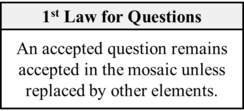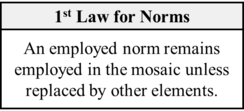Modification:Sciento-2023-0002
Accept new formulations of the first law for theories, norms, and questions that are in tune with the formulation of the first law. Also accept new formulations of the respective rejection theorems - theory rejection, norm rejection, and question rejection.
The modification was suggested to Scientonomy community by Aayu Pandey on 28 December 2023.1 The modification is currently being evaluated; a verdict is pending.
Contents
Preamble
There are currently several problems with the current formulations of the first laws for theories, methods, and questions, as well as the respective rejection theorems. New formulations for these laws and theorems are suggested to ensure their uniformity and the validity of their deductions.
Modification
Theories To Accept
- The First Law for Questions (Barseghyan-Levesley-2021): An accepted question remains accepted in the mosaic unless replaced by other elements.
- The First Law for Norms (Barseghyan-Pandey-2023): An employed norm remains employed in the mosaic unless replaced by other elements.
- The First Law for Theories (Barseghyan-Pandey-2023): An accepted theory remains accepted in the mosaic unless replaced by other elements.
- Theory Rejection theorem (Barseghyan-Pandey-2023): A theory becomes rejected when other elements that are incompatible with the theory become part of the mosaic.
- Norm Rejection theorem (Pandey-2023): A norm becomes rejected when other elements that are incompatible with the norm become part of the mosaic.
- Question Rejection theorem (Barseghyan-Levesley-Pandey-2023): A question becomes rejected when other elements that are incompatible with the question become part of the mosaic.
Theories To Reject
- Theory Rejection theorem (Barseghyan-2015): A theory becomes rejected only when other theories that are incompatible with the theory become accepted.
- Method Rejection theorem (Barseghyan-2015): A method ceases to be employed only when other methods that are incompatible with the method become employed.
- Question Rejection theorem (Barseghyan-Levesley-2021): A question becomes rejected when other elements that are incompatible with the question become accepted.
- The First Law for Theories (Barseghyan-2015): An accepted theory remains accepted unless replaced by other theories.
- The First Law for Methods (Barseghyan-2015): An employed method remains employed unless replaced by other methods.
Questions Answered
This modification attempts to answer the following question(s):
- Mechanism of Theory Rejection:
- Mechanism of Question Rejection: How do questions become rejected? What is the mechanism of question rejection?
- Mechanism of Scientific Inertia for Theories: What makes the theories of an agent's mosaic continue to remain in the mosaic?
- Mechanism of Scientific Inertia for Normative Theories: What makes the normative theories of an agent's mosaic continue to remain in the mosaic?
- Mechanism of Scientific Inertia for Questions: What makes the questions of an agent's mosaic continue to remain in the mosaic?
- Mechanism of Normative Theory Rejection: How do normative theories become rejected? What is the mechanism of normative theory rejection?
Verdict
The modification is currently being evaluated; a verdict is pending.
Click on the Discussion tab for comments.
References
- ^ Pandey, Aayu. (2023) Dilemma of the First Law. Scientonomy 5, 25-46. Retrieved from https://scientojournal.com/index.php/scientonomy/article/view/42258.





